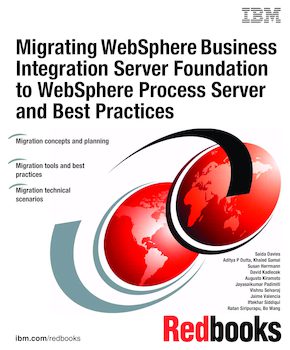Migrating WebSphere Business Integration Server Foundation to WebSphere Process Server & Best Practices
An IBM Redbooks publication
Note: This is publication is now archived. For reference only.

Published on 29 April 2008, updated 30 April 2008
ISBN-10: 0738485632
ISBN-13: 9780738485638
IBM Form #: SG24-7416-00
Authors: Saida Davies, Aditya P Dutta, Khaled Gamal, Susan Herrmann, David Kadlecek, Augusto Kiramoto, Jayasaikumar Padimiti, Vishnu Selvaraj, Jaime Valencia, Iftekhar Siddiqui, Ratan Siripurapu and Bo Wang
In this IBM® Redbooks publication, we discuss the concepts, differences, and migration paths that you must understand before you attempt to migrate the artifacts that you created using the IBM WebSphere® Studio Application Developer Integration Edition 5.1 product to the IBM WebSphere Integration Developer 6.0.2. We also include a discussion on how to migrate models that are developed in WebSphere Business Integration Modeler 5.1 to WebSphere Business Modeler 6.0.2.
In this book, we provide guidance on how to migrate the processes that are installed and running in WebSphere Business Integration Server Foundation to the new integration platform. We also tell you how to bring your components and artifacts to this new generation of integration paradigm.
Part 1, "Products overview and migration planning" on page 1 of this book provides a product overview and helps you to assess your environment and plan WebSphere Business Integration Server Foundation migration to WebSphere Process Server 6.0.2
Part 2, "Migration procedure" on page 51 provides detailed steps that are required for migration and includes the tools that are available, the artifacts that are involved, and best practices. In this section, we also demonstrate the migration process using practical migration scenarios that cover most of WebSphere Business Integration Server Foundation capabilities, which includes process choreography, human activities and staff assignment, and exception and error handling.
Part 1. Products overview and migration planning
Chapter 1. Introduction to the redbook
Chapter 2. Product overview
Chapter 3. Migration concepts
Chapter 4. Migration planning
Part 2. Migration procedure
Chapter 5. Migration options
Chapter 6. Migrating build time artifacts
Chapter 7. Migrating runtime components
Chapter 8. Best practices
Chapter 9. Technical scenarios
Chapter 10. Troubleshooting
Appendix A. Additional material